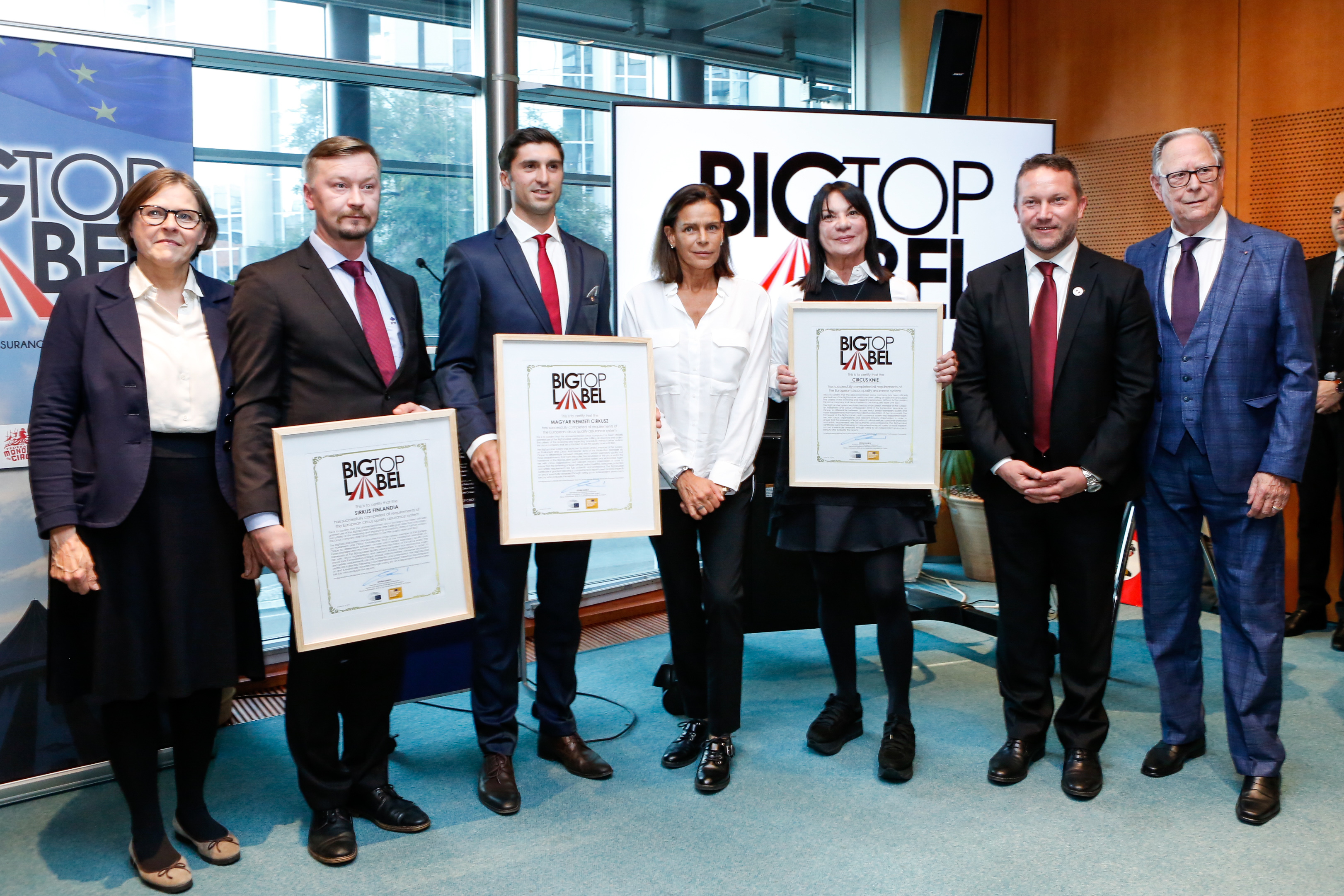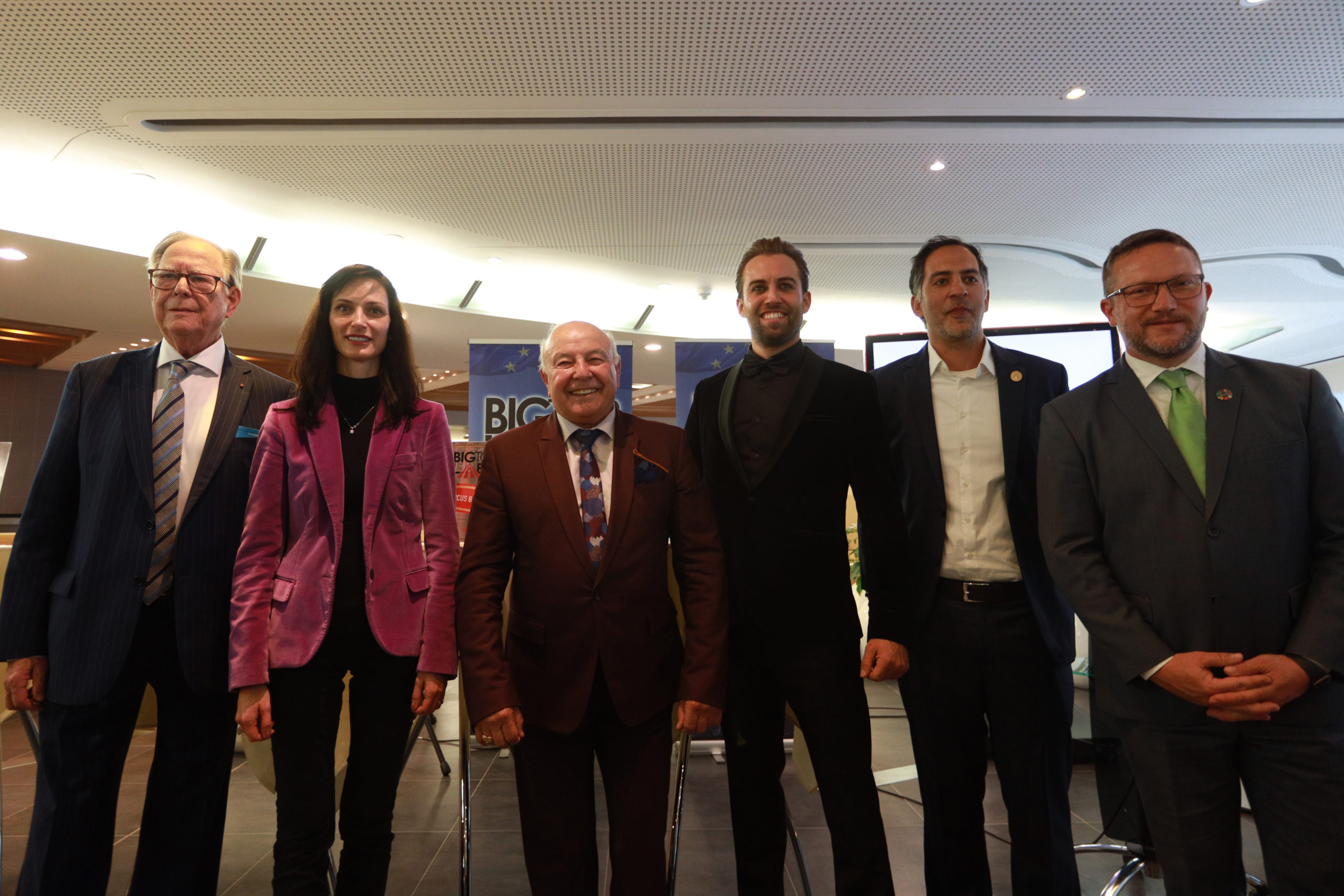2018

Blackpool Tower Circus
The Circus first opened to the public on 14 May 1894. The Tower Circus has never missed a season since it began in 1894, not even during the World Wars. The Circus is positioned at the base of The Blackpool Tower between its four legs. Animals have not appeared in The Blackpool Tower Circus performances since 1990.
Since 1991, the circus has been home to the Endrész family, where they have created a Circus legacy that has become renowned worldwide. Born in Hungary in 1945, Laci Endresz Snr is a sixth generation Circus family member who graduated from the Hungarian Circus Academy and spent 25 years perfecting the flying trapeze. His wife Maureen has an equally impressive pedigree, being a member of the famous Roberts Brothers Circus family, specializing in foot juggling and balancing. Their three children, Kate, Laci Jnr and Bubu all followed them into the ring at an early age. Laci Jnr, born in Eastbourne, made his first appearance as a Circus Clown at the tender age of 4! Although now synonymous with the character Mooky, Laci Jnr first drew international acclaim as a juggler, appearing with his sister Kate. He has worked in most of the leading Circuses in Europe, appeared on the Paul Daniels TV special three times, performed before the late HRH Princess Margaret in the Royal Command Performance and Prince Rainier in the Monte Carlo Circus Festival. His younger brother Bubu has now also firmly established himself as a top Circus entertainer at The Blackpool Tower Circus. 2016 has seen a celebration of 25 years of the Endresz Circus family here at The Blackpool Tower Circus, showcasing similar astounding acts that have performed at The Tower Circus over the last 25 years.
Cirque Arlette Gruss
The Arlette Gruss circus is one of the most popular circus’ in France. The circus was first created in 1985 by Madame Arlette Gruss (1930-2006) and seven generations of Gruss’ have kept the circus running through the years, with each yearly show more exciting and inventive than the last. Today the Circus Gruss holds a special place in the hearts of many French families and is known for its universal appeal to all ages in the family. Each performance is a futuristic imagining of the circus, complete with acrobats, clowns and animals. The Arlette Gruss Circus is well known for its love of technology and reinvention, constantly keeping their shows fresh. The circus itself occupies 2,700m2 when set up and even has a zoo! Gilbert Gruss, the current director of the circus famously quoted Picasso when asked about his circus saying, “Everything I can imagine can one day become real.”
Circus Krone
Circus Krone, based in Munich, is one of the largest circuses in Europe and one of the few in Western Europe to also occupy a building (Cirque d’hiver de Paris, Cirque d’hiver d’Amiens and Cirque Royal in Brussels are some other examples of European circuses occupying a building). It was founded in 1905 by Carl Krone. On December 12, 1944, the building was destroyed by bombing attacks. In 1950 it was rebuilt as a circus building with a seating capacity of 3,000 spectators. In a century, the Circus Krone Imperium became a world-wide recognized institution within the circus world. The outstanding success is based on the maxim “entrepreneur spirit, love of animals and absolute seriousness”. This maxim has been maintained throughout the illustrious history of the family owned and operated Circus Krone. Carl Krone died in 1943. He did not experience the total destruction of the Circus Krone Building, a destruction caused by aerial bombardment. Humans and animals were evacuated to the Krone Stud Farm in Wessling. Circus Krone has a circus tent with 5,000 seats with a diameter of 48 by 64 metres and a dome height of 14 metres. It covers an overall area of approximately 2,000 square metres. The largest, most modern and most expensive circus tent of the present can only be described. The construction of the enormous tent allows for the seating of 5.000 spectators. Four 20 meters long steel masts, four steel lattice auxiliary masts, 120 storm and cross beams as well as 250 iron anchors provide necessary security, even during the most violent of storms. In less than one day, the gigantic tent construction “stands” with seats, manège, show stage, light and sound controls – ready for performances, officially approved and in top condition. Within the area of the illumination engineering with Krone, standards have been established. Approximately 140 securely installed headlights, as well as eight “golden scans” ensure for the different lighting effects of the individual numbers. Four “searchlights” place artists and animals into the right light. The total area of the tent approximately equates to the area of a football field.
2019

Sirkus Finlandia
Karl-Gustaf Jernström established Sirkus Finlandia in 1976.The first show of Circus Finlandia was performed 21 April 1976 in Tammisaari, Finland. Today Circus Finlandia is the only Finnish circus of international standards. It is also a member of European Circus Association. About 200 000 Finns attend Circus Finlandia’s show each year. Karl-Gustav Jernström and his spouse Leena Jurvakainen have four children of which three are working with the family circus: Maria, Anna, Heidi and Carl Johan . They have also four grandchildren (Maria’s, Anna’s and Heidi’s children): Anita, Aleksia, Katerina and Charlie. In addition to performers the circus employs about 45 people. The number of performers and band together is about 35 people. The director of Sirkus Finlandia is now Carl Johan Jernström (Calle Jr Jernström), the son of Karl-Gustav Jernström.
Magyar Nemzeti Cirkusz – Hungarian National Circus
The Hungarian National Circus – celebrating its 25th birthday this year – has been the largest and most high-quality travel circus in Hungary from the beggining, and in the recent years has been one of Europe’s top 5 circuses. Its founder, József Richter, was the only Hungarian artist to receive the Kossuth Prize from the Hungarian State for his high-quality circus work in Hungary. Each year, the Hungarian National Circus presents an impressive brand-new international gala show in Budapest and 22 other cities around Hungary. The director of the circus, József Richter Jr. won the Gold Award at the Budapest International Circus Festival in 2014 and the Monte-Carlo International Circus Festival in 2018. Since 1997, the Hungarian National Circus has hosted every summer two full months in Balatonlelle. Over the years, the opening night of the season, the parade, the Elephant bathing in Lake Balaton and the Night of the Circuses have become curiosities of the Hungarian Sea. Summer circus performances attract more and more spectators to the Circus Square in Balatonlelle. In the summer of 2019, the Hungarian National Circus set 53 performances in Balatonlelle and nearly 60,000 spectators saw the 25th Anniversary Gala of the circus. During his 22 years at the Hungarian Sea, Balatonlelle became the second home of the Hungarian National Circus and the Richter family.
Circus Knie – Schweizer National-Circus Knie
The largest circus of Switzerland, based in Rapperswil. The circus was founded in 1803 by the Knie family and has existed in its present form since 1919 when it changed from an open arena to a covered tent. The circus has been long famous for its animals and now operates a zoo (Knie’s Kinderzoo). Its museum in Rapperswil closed in July 2017. In 1999 Franco Knie was named Best Animal Tamer at the International Circus Festival of Monte-Carlo. Today the circus is an enterprise with about 200 employees, operated by Frédy and Franco Knie in partnership with insurance company Swiss Life. Tightrope acrobat David Dimitri has been associated with the circus. A co-production with Cirque du Soleil was mounted in 1992. In 1999 Karls kühne Gassenschau toured with the Swiss national Circus. In 2000 was the focus on Hanna & Knill including six clown cabarets with Ueli Bichsel, Neda und Maite, and Gardi Hutter. Ursus & Nadeschkin became in 2002 the leading act and headline of the Circus Knie, performing 257 times during the 2002 season tour and having an audience totaling one million spectators.
2022

Circus Balkanski (Bulgaria)
The story of Balkanski family’s contribution to the circus art started 195 years ago. In the distant year of 1820, Alexander Balkanski’s grand grandfather Josef Guintini founded circus Guintini. Fifty- nine years later, he established temporary premises in Samara and Moscow which are afterwards renamed into circus Virginia. In 1916 the circus is sequestered. The family decides to relocate from Odessa to Italy. On their way, they make a stop in the town of Varna and decide to stay in Bulgaria where they found their second homeland. In 1920 Josef Guintini’s brother – the clown Charlie founded the third circus called Rex. Later it is renamed to circus Levski. Until the World War II it worked under the name of Europe. After the nationalization (1948) the members of the family remained working as state circus artists until 1989. At the age of 38 (in 1980) Alexander Balkanski senior created circus troupe Balkanski. At the beginning, the troupe performed five tricks: acrobatics, persh, bicycle, kopf-trapeze. Their premier was in Sofia in 1981. Three consecutive years troupe Balkanski worked in Denmark, Switzerland, Greece and Italy and from 1985 to 1999 in Germany. In 2000 Alexander Balkanski and his sons Alexander and Nikolai founded Circus Balkanski. During the same year Circus Balkanski began performing in Bulgaria, then they have made shows also in Turkey and Israel. Troupe Balkanski has unforgettable memories from their tours in 1986,1993 and 2000 in Vatican where they performed for the Pope. They participated in spectacles for the English, Dutch, Swedish and Danish queens. Acknowledgments and awards are of great number, for example: 1983 – „Silver clown” – Monte Carlo 1982- Nikolai Balkanski – the younger Alexander Balkanski’s son is signed in the book of Guinness World Records with his double somersault on one and two stilts.
Circus Brazil Jack (Sweden)
The circus history of the Rhodin family dates back to 1899, when 28-year-old Carl Rhodin (1871-1952), known as Brazil Jack, started the circus that still bears his name. The stage name was born as a tribute to the American entertainer William F Cody (Buffalo Bill), whose wild west show was a great success in Europe between 1887 and 1893. In the beginning, the show involved stagecoach-robberies, shootings, lasso tricks, knife throwing – whatever a real western show needs. After several detours, in 1941 his son Trolle took over the management of the family business, under his hands the troupe named Zoo Circus developed into an international circus – later on he became one of the artistic directors of the Ringling brothers’ in the USA. He star- ted his European career again in 1982, when Cirkus Brazil Jack was formed back, namely „in memory of the grandfather”. The troupe featuring classic circus elements is currently managed by Trolle’s grandson, one of the youngest circus directors in Europe. Trolle Rhodin, born in 1988, gave the company, which was drowning in debt, a whole new impetus as art director and technical manager.
Circus Roncalli (Germany)
Circus Roncalli is a German professional circus founded in 1976 by Bernhard Paul and André Heller. According to Bernhard Paul, the name was suggested by fellow Austrian Peter Hajek and his film script Sarah Roncalli, Tochter des Mondes [Sarah Roncalli, Daughter of the Moon], named after Pope John XXIII whose civil name was Angelo Giuseppe Roncalli. Paul and Heller agreed on it because of its pleasant sound and the pope’s reform agenda. The first performance of the circus was on 18 May, 1976 on the Hofgartenwiese in Bonn, and the tour finished on 16 August, 1976 in Munich. After the first season, Paul and Heller had a dispute over the concept and the rights, so at a future performance on 4 June, 1980 in Cologne, Bernhard Paul directed the circus on his own. (In September 1976, there were already performances without Heller in Vienna, but the show closed after a short run owing to a dwindling audience.) Since then, the circus has toured in Germany and abroad, including the first appearance of a West German circus in the Soviet Union in 1986. Model-turned-photographer Ellen von Unwerth worked as an assistant at Circus Roncalli in Munich for around a month when she was
18 years old. The winter quarters of the circus have been at Neurather Weg 7 in Mülheim,
Cologne, since 1984. The building belonged to Circus Williams previously, and was rebuilt to accommodate Circus Roncalli, and then was officially opened on 27 April, 1986.
2023

CIRCO RALUY LEGACY (SPAIN)
It’s story, like that of so many other families in the circus world, goes back several generations. The name comes from Luis Raluy Iglesias, born in 1911, who grew up near Barcelona. Although the family had no money to buy him circus tickets as a young child, he once wandered into a travelling circus tent and was fascinated with what he saw there for life. Luis started out as an acrobat with the Keystone Trio, and later became known for his inventive innovations as Bullet Man. Between the 1930s and 1960s, he performed in the world’s top circuses and theatres, always accompanied on tour by his family, his wife Marina Tomas Jorba – and later their children Luis, Carlos, Eduardo and Francis. By the 1970s, the Raluy family ran their own circus, touring Spain and Portugal. The travelling circus was based on wagons bought and renovated by Luis, now an older man. These are still iconic elements of the Circo Raluy Legacy caravan and the circus museum and mobile hotel that the family founded. In 1984, Luis Jr. together with his brother Carlos Raluy, took over the Ringland Circus, belong- ing to the family, while his other brothers Francis and Eduard founded the Williams Circus based in Mallorca. Between 1984 and 1992, Ringland toured the Caribbean and the West Indies and returned to Catalonia in 1992 to perform as Circus Raluy. Luis Raluy passed away in 2021, and the family circus is now called Circo Laruy Legacy. It is run by his two daughters Louisa and Kerry, with the late Luis’s two sons-in-law and four grand- children also actively involved.
RICHTER FLÓRIÁN CIRKUSZ (HUNGARY)
Flórián Richter was born on 18 November 1977 in Stuttgart (DE), the child of the seventh generation of a family of acrobats. Flórián started his career as an artist at the age of nine as an equestrian acrobat as his mother had an accident in Japan and he had to replace her. After many years of training, he achieved great success with his equestrian performances. In 2003, he was awarded the Károly Hortobágyi Prize as a riding acrobat of the Hungarian National Circus. In 2004, he won the Silver Clown Award and three special prizes at the 28th Monte Carlo International Circus Festival for his equestrian performance with his wife. In 2008, he won the Golden Clown Award at the 32nd Monte Carlo International Circus Festival with his own equestrian acrobatic group, which he founded in 2005. In 2009, he founded his own equestrian programme, the Horse Evolution Show, which focuses on the relationship between man and horse. After its world premiere, the show was a success all over Europe, and in 2012 and 2013 it was also presented in Hungary’s cities as part of a cross- country tour. At the Budapest Circus Festival in January 2018, he and his son Kevin performed one of the circus classics, the postal act, to great acclaim.
ZIPPOS CIRCUS (UNITED KINGDOM)
Zippos Circus was established by Martin Burton (b.1954) in 1986. Martin, a qualified teacher with an interest in performance, started to work with a mime troupe in the 1970s and by 1976 he was pursuing a career in clowning. On the following three years Martin appeared many times at London’s Roundhouse with his clowning act, which was followed by a tour of Australia. In 1980 Martin suffered a serious accident while performing a fire eating act and was hospitalized for a year while undergoing reconstructive surgery. Once he recovered he started training with veteran acrobat Johnny Hutch (1913-2006), who had famously won the Circus World Championships aged 64 years old. Martin never thought of establishing his own circus until he met Johnny, who eventually convinced him to become an impresario. Martin applied for a grant from British Petroleum for a unique and modern design of circus tent and started operating Zippos circus in 1986 on Highbury Fields. From the onset, Zippos Circus was a very modest, animal free show, which relayed heavily on the quality of the performers and the entertainment provided by the clowns. The initial cast was formed by four clowns, two jugglers and a pianist, over the years the cast grew to offer a range of performances and include equestrian acts as well as Sir Norman Barrett’s budgerigar act. Norman Barrett (b.1935) joined Zippo Circus’s as its Ringmaster in 2004 and he still remained in this role in 2021. Zippos Circus also presents Cirque Berserk, a theatre stage based circus show.
